Monday, 9 March 2015
THE VICTORIAN BUILDING AS OPPOSED TO THE GEORGIAN
The eighteenth century in English literature has been called the Augustan Age, the Neoclassical Age, and the Age of Reason. The term 'the Augustan Age' comes from the self-conscious imitation of the original Augustan writers, Virgil and Horace, by many of the writers of the period.
An enormous emphasis was placed on the ability to think and reason during the Enlightenment. People during this era thought and reasoned about a variety of topics. The first epistle of Alexander Pope’s “Essay on Man” can be considered an articulation of the Enlightenment because it encompasses three major concerns of the people during the Enlightenment. Pope addresses man’s ability to reason and think for himself, he questions the church and the nature of Christianity, and he also speculates about man’s place in the world, as a part of the great chain of life.
The ability to reason was the central focus of the Enlightenment also denoted The Age of Reason.

An enormous emphasis was placed on the ability to think and reason during the Enlightenment. People during this era thought and reasoned about a variety of topics. The first epistle of Alexander Pope’s “Essay on Man” can be considered an articulation of the Enlightenment because it encompasses three major concerns of the people during the Enlightenment. Pope addresses man’s ability to reason and think for himself, he questions the church and the nature of Christianity, and he also speculates about man’s place in the world, as a part of the great chain of life.

The ability to reason was the central focus of the Enlightenment also denoted The Age of Reason.
Pope encourages his audience to use the reason they have been given, to examine those things that have been advised against, asking them to look for evidence in the knowledge they receive, rather then allowing the church to spoon-feed them all of their knowledge.
Pope expresses his opinion that man’s place in the Universe, is within “Nature’s chain.” Therefore, man is simply a link within that chain. Pope’s idea that there is this chain or structure to the Universe, is representative of the belief by many Enlightenment thinkers, that there is a “best” way to structure things. During the Enlightenment everything was being organized, and classified. From the structure of society, to the structure of the Universe, there existed a common belief that organization was key to producing the “best” of anything.
Pope expresses his opinion that man’s place in the Universe, is within “Nature’s chain.” Therefore, man is simply a link within that chain. Pope’s idea that there is this chain or structure to the Universe, is representative of the belief by many Enlightenment thinkers, that there is a “best” way to structure things. During the Enlightenment everything was being organized, and classified. From the structure of society, to the structure of the Universe, there existed a common belief that organization was key to producing the “best” of anything.
Specifically, the Augustan Age was the period after the Restoration era to the death of Alexander Pope (~1690 - 1744). The major writers of the age were Pope and John Dryden in poetry, and Jonathan Swift and Joseph Addison in prose.
It is the name of Alexander Pope which is associated with the epoch known as the Augustan Age, despite the fact that other writers such as Jonathan Swift and Daniel Defoe had a more lasting influence. The 1st half of the 18th century is called the “Augustan age” because of the attention paid to the characteristics of ancient Rome under the Emperor Augustus. Chiswick House 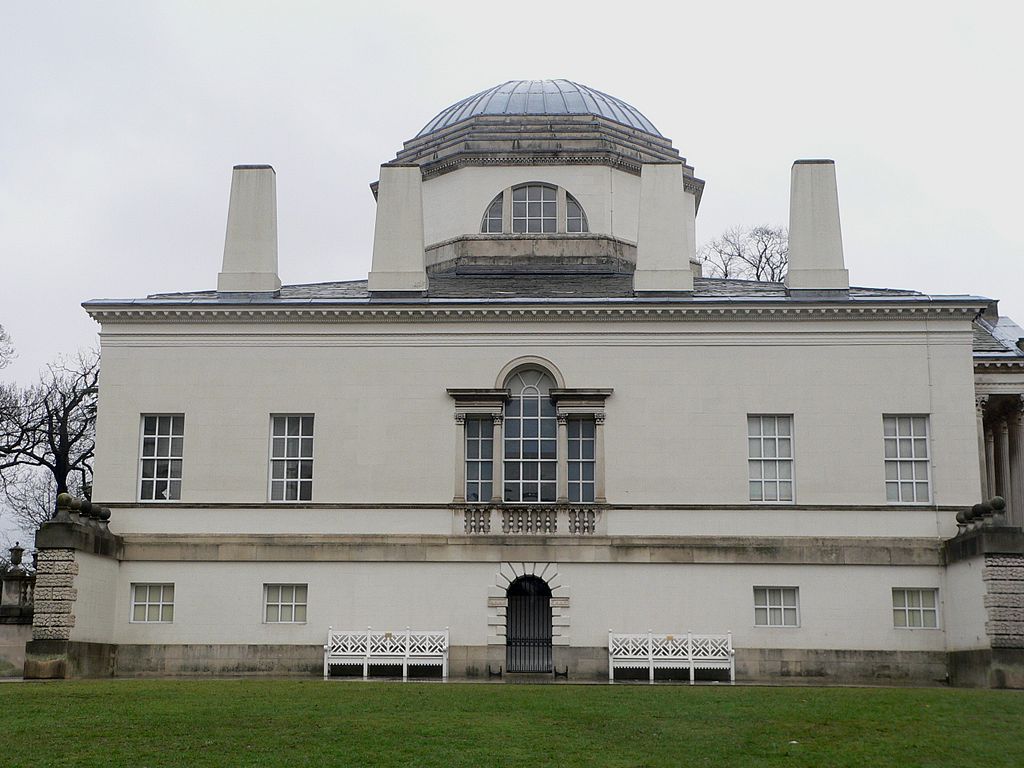 is an example of English Palladian Architecture in Burlington Lane, Chiswick, in the London Borough of Hounslow in England.
is an example of English Palladian Architecture in Burlington Lane, Chiswick, in the London Borough of Hounslow in England.
 is an example of English Palladian Architecture in Burlington Lane, Chiswick, in the London Borough of Hounslow in England.
is an example of English Palladian Architecture in Burlington Lane, Chiswick, in the London Borough of Hounslow in England.
Arguably the finest remaining example of Neo-Palladian architecture in London, the house was designed by Lord Burlington, and completed in 1729. The architectural historian Richard Hewlings has established that Chiswick House was an attempt by Lord Burlington to create a Roman villa, rather than Renaissance pastiche, situated in a symbolic Roman garden.The Roman garden was a place of peace and tranquillity – a refuge from urban life – and a place filled with religious and symbolic meanings
Chiswick House is inspired in part by several buildings of the 16th-century Italian architects Andrea Palladio (1508–1580) and his assistant Vincenzo Scamozzi (1552–1616).
The house is often said to be directly inspired by Palladio's Villa Capra "La Rotonda" near Vicenza, Lord Burlington had rejected this design and it was subsequently used at Mereworth Castle, Kent.
"La Rotonda" near Vicenza, Lord Burlington had rejected this design and it was subsequently used at Mereworth Castle, Kent.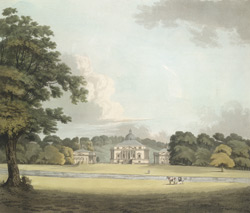 Whether Palladio's work inspired Chiswick or not, the Renaissance architect exerted an important influence on Lord Burlington through his plans and reconstructions of lost Roman buildings;
Whether Palladio's work inspired Chiswick or not, the Renaissance architect exerted an important influence on Lord Burlington through his plans and reconstructions of lost Roman buildings;
 Whether Palladio's work inspired Chiswick or not, the Renaissance architect exerted an important influence on Lord Burlington through his plans and reconstructions of lost Roman buildings;
Whether Palladio's work inspired Chiswick or not, the Renaissance architect exerted an important influence on Lord Burlington through his plans and reconstructions of lost Roman buildings;
The Augustans had turned to classical Rome and Greece, and the ruling class thought to be the true heir of the Roman Empire.
The real English gentleman had the old Roman fortitude, perseverance, and forbearance together with Stoic pride. The great Augustan writers share a belief in reason as capable of imposing some order on an otherwise chaotic world.
In this period rules were important: hey were laid down for every aspect of life, from religion and philosophy to art and sports; from this derives the didactic tone of much Augustan literature. The Augustans were convinced that their aesthetic and moral canons were perfect because they conformed to nature, which they saw as the principle of universe, and to classical rules.
Neo-classicism became a style of life, that influenced poetry, sculpture, painting and gardening and town planning.
As regarding architecture, in the 1730s there was a revolution that broke with the baroque followers of Christopher Wren; many British cities were adorned with classical terraces, squares and crescents, and the gothic style was popular too.The age of reason or “the Enlightenment had particular characteristics that distinguished England from the other European countries.
Many travellers were surprised by what they saw as the comparative freedom enjoyed by the British people in contrast with the more absolutist regimes of their own countries.
'Neoclassicism'
This 'nature' of the Augustans, however, was not the wild, spiritual nature the romantic poets would later idealize, but nature as derived from classical theory: a rational and comprehensible moral order in the universe, demonstrating God's providential design.
The architectural style produced by the neoclassical movement that began in the mid-18th century. In its purest form it is a style principally derived from the architecture of Classical antiquity, theVitruvian principles and the architecture of the Italian architect Andrea Palladio.
This 'nature' of the Augustans, however, was not the wild, spiritual nature the romantic poets would later idealize, but nature as derived from classical theory: a rational and comprehensible moral order in the universe, demonstrating God's providential design.
The architectural style produced by the neoclassical movement that began in the mid-18th century. In its purest form it is a style principally derived from the architecture of Classical antiquity, theVitruvian principles and the architecture of the Italian architect Andrea Palladio.
In form, Neoclassical architecture is manifested both in its details as a reaction against the Rococo style of naturalistic ornament, . Neoclassical architecture is still designed today, but may be labelled New Classical Architecture for contemporary buildings.
It was symptomatic of a desire to return to the perceived "purity" of the arts of Rome, to the more vague perception ("ideal") of Ancient Greek arts . The idea was that a building should immediately communicate its function to the viewer: taken literally such ideas give rise to "architecture parlante". The baroque style  had never truly been to the English taste. At first the book mainly featured the work of Inigo Jones, but the later tomes contained drawings and plans by Campbell and other 18th-century architects. Palladian architecture became well established in 18th-century Britain.
had never truly been to the English taste. At first the book mainly featured the work of Inigo Jones, but the later tomes contained drawings and plans by Campbell and other 18th-century architects. Palladian architecture became well established in 18th-century Britain.
Inigo Jones was the first significant British architect of the early modern period, and the first to employ Vitruvian rules of proportion and symmetry in his buildings.
Little is known about Vitruvius' life. Most inferences about him are extracted from his only surviving work De Architectura. His first name Marcus and his cognomen Pollio are uncertain.
 had never truly been to the English taste. At first the book mainly featured the work of Inigo Jones, but the later tomes contained drawings and plans by Campbell and other 18th-century architects. Palladian architecture became well established in 18th-century Britain.
had never truly been to the English taste. At first the book mainly featured the work of Inigo Jones, but the later tomes contained drawings and plans by Campbell and other 18th-century architects. Palladian architecture became well established in 18th-century Britain.Inigo Jones was the first significant British architect of the early modern period, and the first to employ Vitruvian rules of proportion and symmetry in his buildings.
Little is known about Vitruvius' life. Most inferences about him are extracted from his only surviving work De Architectura. His first name Marcus and his cognomen Pollio are uncertain.
Gerolamo Cardano, in his 16th book De subtilitate rerum, ranks Vitruvius as one of the 12 persons whom he supposes to have excelled all men in the force of genius and inventionVitruvius is the author of De architectura, known today as The Ten Books on Architecture, a treatise written in Latin on architecture, dedicated to the emperor Augustus. This work is the only surviving major book on architecture from classical antiquity. According to Petri Liukkonen, this text "influenced deeply from the Early Renaissance onwards artists, thinkers, and architects, among them Leon Battista Alberti (1404–1472), Leonardo da Vinci (1452–1519), and Michelangelo (1475–1564).The next major book on architecture, Alberti's reformulation of Ten Books, was not written until 1452.
Vitruvius is famous for asserting in his book De architectura that a structure must exhibit the three qualities of firmitas, utilitas, venustas – that is, it must be solid, useful, beautiful. These are sometimes termed the Vitruvian virtues or the Vitruvian Triad. According to Vitruvius, architecture is an imitation of nature. As birds and bees built their nests, so humans constructed housing from natural materials, that gave them shelter against the elements. When perfecting this art of building, the Greeks invented the architectural orders: Doric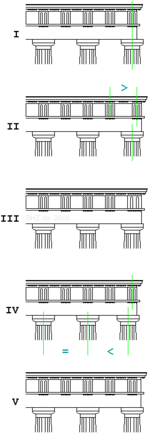 , Ionic
, Ionic and Corinthian
and Corinthian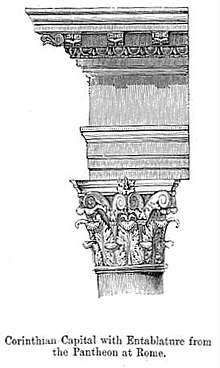 . It gave them a sense of proportion, culminating in understanding the proportions of the greatest work of art: the human body.
. It gave them a sense of proportion, culminating in understanding the proportions of the greatest work of art: the human body.
 , Ionic
, Ionic and Corinthian
and Corinthian . It gave them a sense of proportion, culminating in understanding the proportions of the greatest work of art: the human body.
. It gave them a sense of proportion, culminating in understanding the proportions of the greatest work of art: the human body.
Roman architects practised a wide variety of disciplines; in modern terms, they could be described as being engineers, architects, landscape architects, artists, and craftsmen combined. Etymologically the word architect derives from Greek words meaning 'master' and 'builder'.
His book De architectura was rediscovered in 1414 by the Florentine humanist Poggio Bracciolini.Giocondo.

above Ionic

above Doric


Corinthian
The buildings and architecture of Bath, a city in Somerset in the south west of England, reveal significant examples of the architecture of England,and the way in which the city landscape draws together public and private buildings and spaces.The many examples of Palladian architecture are purposefully integrated with the urban spaces to provide "picturesque aestheticism".Important buildings include the Roman Baths; neoclassical architect Robert Adam's Pulteney Bridge,
 based on an unused design for the Rialto Bridge in Venice and the residential buildings designed and built into boulevards and crescents by the Georgian architects John Wood, the Elder and his son John Wood, the Younger – well-known examples being the Royal Crescent,
based on an unused design for the Rialto Bridge in Venice and the residential buildings designed and built into boulevards and crescents by the Georgian architects John Wood, the Elder and his son John Wood, the Younger – well-known examples being the Royal Crescent, built around 1770, and The Circus,
built around 1770, and The Circus, built around 1760, where each of the three curved segments faces one of the entrances, ensuring that there is always a classical facade facing the entering visitor.
built around 1760, where each of the three curved segments faces one of the entrances, ensuring that there is always a classical facade facing the entering visitor.
Most of Bath's buildings are made from the local, golden-coloured, Bath Stone. The dominant architectural style is Georgian,which evolved from the Palladian revival style that became popular in the early 18th century. an integration of architecture, urban design, and landscape setting, and the deliberate creation of a beautiful city. 

Victorian refers to the reign of Queen Victoria (1837–1901), called the Victorian era, during which period the styles known as Victorian were used in construction. However, many elements of what is typically termed "Victorian" architecture did not become popular until later in Victoria's reign. The styles often included interpretations and eclectic
(the borrowing of a variety of styles from different sources and combining them)
revivals of historic styles mixed with the introduction of middle east and Asian influences. The name represents the British and French custom of naming architectural styles for a reigning monarch. Within this naming and classification scheme, it follows Georgian architecture and later Regency architecture, and was succeeded by Edwardian architecture.
Edwardian architecture is generally less ornate than high or late Victorian architecture.

During the early 19th century, the romantic medieval Gothic revival style was developed as a reaction to the symmetry of Palladianism, (below St.Pancras Station). In the face of the idustrial revolution crushing nature in its path some Victorians harked back to the past in their search for meaning and writing, painting and art
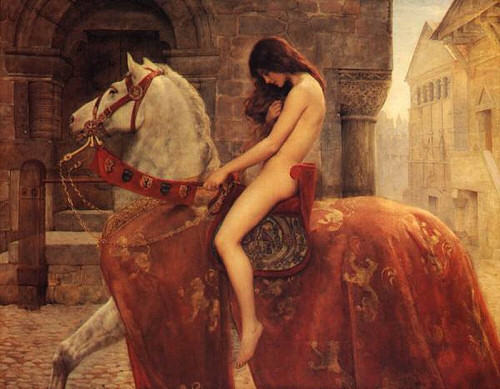 plus architecture and gardens looked to the past for an answer .
plus architecture and gardens looked to the past for an answer .  Others wanted a national architecture to demonstrate the power of the empire just as Rome had done and Mussolini and Hitler would try to recreate . Neo-Gothis would be the chosen style of architecture as it fulfilled the needs of those Victorians who wanted the past for various reasons.
Others wanted a national architecture to demonstrate the power of the empire just as Rome had done and Mussolini and Hitler would try to recreate . Neo-Gothis would be the chosen style of architecture as it fulfilled the needs of those Victorians who wanted the past for various reasons.  and such buildings as Fonthill Abbey were built.
and such buildings as Fonthill Abbey were built. By the middle of the 19th century, as a result of newtechnology, construction was able to incorporate steel as a building component; one of the greatest exponents of this was Joseph Paxton, architect of the Crystal Palace.
By the middle of the 19th century, as a result of newtechnology, construction was able to incorporate steel as a building component; one of the greatest exponents of this was Joseph Paxton, architect of the Crystal Palace.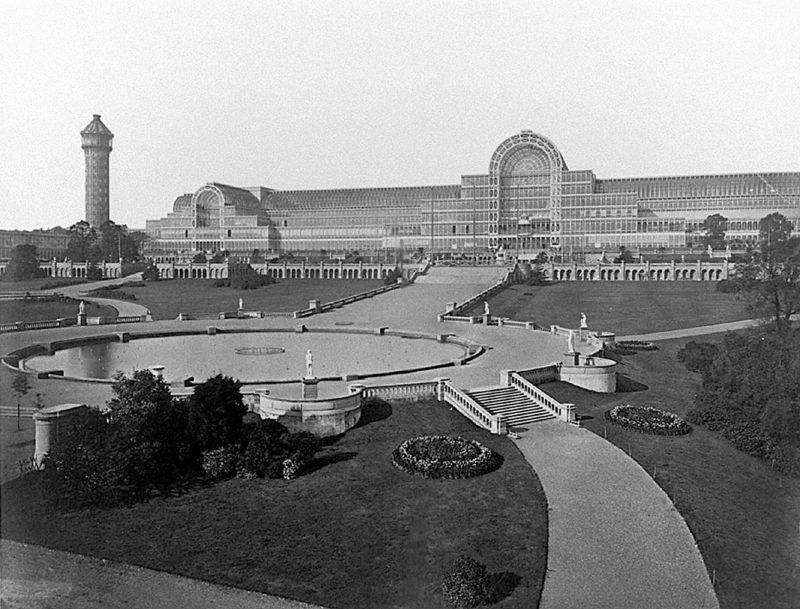 Paxton also continued to build such houses as Mentmore Towers,
Paxton also continued to build such houses as Mentmore Towers,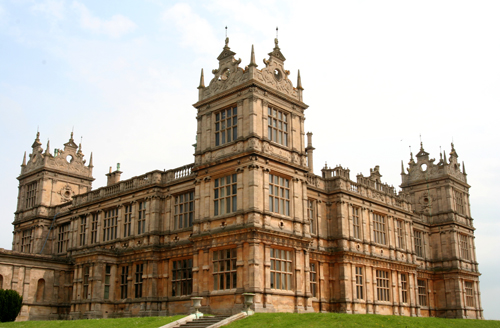 in the still popular English Renaissance styles. In this era of prosperity new methods of construction were developed, but ironically the architectural styles, as developed by such architects as Augustus Pugin, were typically retrospective.
in the still popular English Renaissance styles. In this era of prosperity new methods of construction were developed, but ironically the architectural styles, as developed by such architects as Augustus Pugin, were typically retrospective.
In Scotland, the architect Alexander Thomson  who practiced in Glasgow was a pioneer of the use of cast iron and steel for commercial buildings, blending neo-classical conventionality with Egyptian and oriental themes to produce many truly original structures. Other notable Scottish architects of this period are Archibald Simpson
who practiced in Glasgow was a pioneer of the use of cast iron and steel for commercial buildings, blending neo-classical conventionality with Egyptian and oriental themes to produce many truly original structures. Other notable Scottish architects of this period are Archibald Simpson and Alexander Marshall Mackenzie
and Alexander Marshall Mackenzie  whose stylistically varied work can be seen in the architecture of Aberdeen.
whose stylistically varied work can be seen in the architecture of Aberdeen.
 who practiced in Glasgow was a pioneer of the use of cast iron and steel for commercial buildings, blending neo-classical conventionality with Egyptian and oriental themes to produce many truly original structures. Other notable Scottish architects of this period are Archibald Simpson
who practiced in Glasgow was a pioneer of the use of cast iron and steel for commercial buildings, blending neo-classical conventionality with Egyptian and oriental themes to produce many truly original structures. Other notable Scottish architects of this period are Archibald Simpson and Alexander Marshall Mackenzie
and Alexander Marshall Mackenzie  whose stylistically varied work can be seen in the architecture of Aberdeen.
whose stylistically varied work can be seen in the architecture of Aberdeen.
ALL ideas come from those that leave through a time, their ideas come from the lives they lead and its influences , even a biro pen shows and leaves its mark on who imagined it then designed it and made it . In Georgian architecture we can see simplicity but superbly mathmatical , reason combined with deep understanding of who they were and where they were going . As soon as we encounter the industrial revolution then this idea of reason balance and logic seems to start falling to pieces . Victorian art seems to lose the fine values of Georgian reason . The age of reason becomes the age of unconscious despair within a framework of seemingly great progress . It culminates in the worlds becoming what it is today with the first great serial killer Jack the Ripper maybe a victim of the new age of unreason , a people alienated from nature where nature exists only in the minds of artists and a letter is sent to the newspaper in blood

No comments:
Post a Comment